So Mama Don't Take My Videomatica Away
Saturday, May 07, 2011
Din! Din! Din!
You Lazarushian-leather Gunga Din!
Tho' I've belted you an' flayed you,
By the livin' Gawd that made you,
You're a better man than I am, Gunga Din!
Rudyard Kipling
Kodachrome, they give us those nice bright colours
They give us the greens of summers
Makes you think all the world's a sunny day, oh yeah
I got a Nikon camera, I love to take a photograph
So mama don't take my Kodachrome away
Simon & Garfunkel
 |
| Johnny Weissmuller photo by George Hurrell |
I was born in Buenos Aires and that city's presence in my psyche is indelible. Almost as much is Mexico (Mexico City, Veracruz and the mining town of Nueva Rosita in the northern state of Coahuila). Even my five years (formative years) in Austin have left a lot of Texan in me.
I have no equivalent overpowering soft, fuzzy and warm feeling for Vancouver. And this, even though Vancouver has been most kind to me since I arrived in 1975 with my two Mexican born daughters and Canadian wife. But I feel an inordinate measure of pride for what this city offers.
Vancouver to me has all the features of a great American city without too many of the less attractive trappings that are part of the American (USA American) experience. Few cities besides Vancouver (Portland perhaps?) have a growing population in its inner city core.
In the 80s Vancouver was a big city with a provincial attitude (provincial with a small p). It was a big city because it offered Kodachrome processing. There were few others in North America!
Kodachrome is gone and its processing left Vancouver as soon as Kodak shut its doors on Howe Street. But Vancouver retains at least four labs that process Ektachrome. For this digital photographer who hand loads his cameras with film that has a paper backing this is still a big city indeed.
I tell my Argentine cousins that the electric clock in my kitchen tells accurate time. They do not believe me. I tell my friends in Mexico City that Vancouver’s 110 volts are so steady that the electric motors of refrigerators last forever. They do not believe me. I tell my Argentine godmother that buses in Vancouver are driven by courteous drives and that the buses are clean and even allow for bicycles, wheelchairs. She does not believe me and when I add that the buses lower themselves so that people like her (she is 86) can get on the bus with no danger, she is incredulous.
he piece de resistance is when I tell them that if I lose my driver’s license I can get one in under an hour with no bureaucracy. They say it cannot be true. I don’t tell them that here in Vancouver we have the option not to vote (it is mandatory in Argentina except during military dictatorships) and that we do so in schools that are walking distance from where we live. I tell them that there are no soldiers or guards. I tell them that there are no guns of any kind at these voting stations.
But when I want to really brag about Vancouver I tell them of our Vancouver Public Library with its tremendous collection of books and films and that I can order my choices on line and that they are delivered to my nearest public library while being informed via e-mail.
Then I tell them of Videomatica where I can find just about any film I have ever seen or want to see.
It was perhaps 6 years ago that my Rebecca, then around 7 years old was hanging from our banister like a monkey. I told her that I wanted to show her something. I opened my George Hurrell book and had her look at a photograph of Johnny Weissmuller. Then I ask her to get into the car with me and we go to Videomatica to take out (it was a VHS at the time) Tarzan the Ape Man. We return and see it together. Within hours she is hanging from the banister but this time she is making monkey sounds and attempting Weissmuller’s chest beating yell.
A week later we watch Gunga Din with Cary Grant, Victor McLaglen and Douglas Fairbanks jr. After the film I read her Kipling’s poem. Gunga Din is followed by Sahara with Humphrey Bogart and many more after that. How is one to compensate for that rush of films with perfect animated rats that talk with the voice of Johnny Depp? I compensate with films that show real people talking and where Rebecca has to imagine that Humphrey Bogart is truly driving a General Grant tank and pursued by Germans in a desert back lot in Hollywood.
Videomatica has been a treasure into the great films of the past that cannot be found at Blockbuster or downloaded from Netflix. It has been a treasure into the great films that may have come to Vancouver, even a few months ago that nobody ever noticed.
Videomatica is the only place in Vancouver where you will find Carlos Saura’s Goya in Bordeaux.
 |
| A film by Carlos Saura I took out from Videomatica last week |
People constantly complain of the mediocrity of our Vancouver Sun, yet it always has to be John Mackie (who originally came from Alberta as a manager of a punk band called Popular Mechanics) to tell us, so well, but so sadly how the good things that have made our Vancouver a great city are disappearing without us noticing. And so today Mackie has informed me via the Vancouver Sun that Videomatica will be no more sometime by the end of summer.
Fortunately my Vancouver Public Library has many of the other films of Carlos Saura even if Goya in Bordeaux is not one of them.
King Solomon's Mines
The Corsican Brothers
General Douglas MacArthur & Turkey Wraps From Costco
Friday, May 06, 2011
 |
| General Douglas MacArthur wades ashore during initial landings at Leyte, Philippine Islands, 10/1944, ARC Identifier 531424 / Local Identifier 111-SC-407101, Item from Record Group 111: Records of the Office of the Chief Signal Officer, 1860 - 1982 |
Successful generals are more so when they have good press agents. When General Douglas MacArthur told Filipinos, after he left in a PT boat quickly just before the fall of Corregidor in 1942, “I shall return,” he made sure there was a good photographer around when he waded on the shore of Leyte.
Had this event happened more recently, in our era of 24 hour news there would be blogs questioning if that was indeed MacArthur or his double who got his ankles wet. They would be discussing what brand shirt he was wearing and why it was he was not smoking his corn cob pipe. There might have been theories that MacArthur was showing solidarity to the American tobacco industry and that he was doing his part to make sure that GIs had their tobacco ration. They might have even been questioning if it was indeed correct for an US Army General to be wearing aviator sun glasses.
On Monday night I read in my NY Times the details of the scene in the Situation Room at the White House during the evening of the US Navy Seals raid on Bin Laden’s compound in Pakistan. I had to stop to marvel at the fact that the NY Times had this detail:
On Sunday, White House officials canceled all West Wing tours so unsuspecting tourists and visiting celebrities wouldn’t accidentally run into all the high-level national security officials holed up in the Situation Room all afternoon monitoring the feeds they were getting from Mr. Panetta. A staffer went to Costco and came back with a mix of provisions — turkey pita wraps, cold shrimp, potato chips, soda.
On Tuesday night I was looking for the paper to show Rosemary this startlingly banal detail of the Costco turkey wraps. I could not find it so I keyed into Google: turkey wrap, Costco, Situation Room.
You can see that a screen capture of the Goggle search produced many results on the money!
With the complete takeover of Google and Wikipedia as search engines for facts and (sometimes) knowledge I have been pondering how my life has changed. I still have a Canadian Oxford Dictionary by my bedside table. If there is some word in whatever book I am reading that I don’t know I immediately look it up. But sometimes, when I want to check on some historical fact mentioned in a book I put on my slippers and go downstairs to my computer and Google it.
Since 1986 we have amassed quite a collection of the best gardening books that money can buy. Of that collection there are now fewer than 10 that I ever consult. Google is quicker and easier most times. If I want to read about gardening in an essay form I will opt for the many books of the late Christopher Lloyd but if I want to know what are the growing instructions for Smyrnium perfoliatum I go on line. If I want to look at what roses I might want to buy this late spring I will consult my Peter Beales Classic Roses. There is nothing like a nice thick book on my lap in bed for something like this.
One aspect of Google is that it reflects the increasing of a uniformity of knowledge that comes from globalization.
Just about anybody interested in photography will know of Henri Cartier-Bresson and his pioneering contribution to the “decisive moment” in street photography. Fewer might know of the excellence of his contemporary, Mexican photographer Manuel Álvarez Bravo. But how many know of Hécor García, born in 1923 but very much alive?
I know of Héctor García simply because a friend from Mexico gave me a book of his photographs. I believe that just about every country must have at least one photographer of such caliber and who is only known in the country of birth. Google can find Héctor García if you know of his prior existence. The quality of García's photographs is comparable with that of Cartier-Bresson and yet, outside of Mexico (and perhaps even in Mexico) this master is unknown.
What I can say that is an improvement over the dictionary is that laziness would often prevent me from looking up that word. Now with the availability of the computer or a tablet book device with hypertext search of word meanings one has no excuse for ignorance.
But as I watch the occasional CNN broadcast and the level of detail (what kind of dog accompanied the SEALS?) I come to realize that 24 hours news has a limit. I am not interested in knowing what President Obama had as a snack in the Situation room.
 |
| Héctor García |
Would you believe that bloggers and commentators immediately noticed there was no Costco in DC and so put forward this scenario: Someone on his way from the CIA to the Situation Room was called and asked to stop over at Costco for the snacks. Since Hilary Clinton might be on her way to becoming a diabetic perhaps he was asked to bring some diet soda.
As far as I am concerned all I need to know is that General MacArthur did indeed return. And I don't want to know what he had for lunch.
Kimberley Klaas (Spademan)
Thursday, May 05, 2011
I wrote the blog on Kimberley Klaas on December 18, 2007. Today I was trying to look her up so that she might write a guest blog on her eperience of posing for me. She did that many times. She was a young woman with lots of curiousity and a real pleasure in front of my camera. I did find her in the end. I found her obituary. Kimberley died on 21/09/2009. Kimberley taught me plenty as the pictures, below, plainly show.
Klaas from Weimar
Tuesday, December 18, 2007
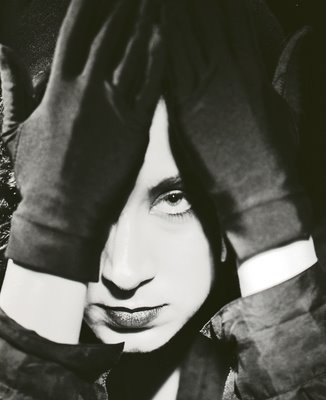
Of late when I photograph someone in my studio I just might shoot a roll of 120 film with all of its 10 exposures. But it is not happening as often. I find myself shooting 5 or 6 and stopping. At one time, when film was king, art directors and photo editors would say, "Shoot lots of film. Film is cheap." With digital cameras (if you don't consider the expense of keeping up with your digital Joneses) it is even cheaper than film as each exposure is free. Film varieties are being discontinued and what remains is expensive. Luckily I still process my own.
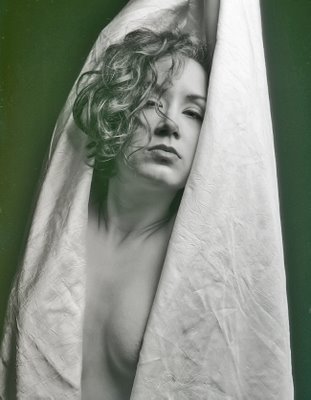
But how is it possible to shoot a magazine assignment with 5 or 6 exposures? I have recently found the answer in my photo classes at Focal Point. My students crop their pictures in all possible ways. Some of these crops work, most don't. But you simply have to do this until your brain's memory stores what works and what doesn't. My students practice on models that the school hires. I supervise and give a few pointers. I am patient. I did the same.
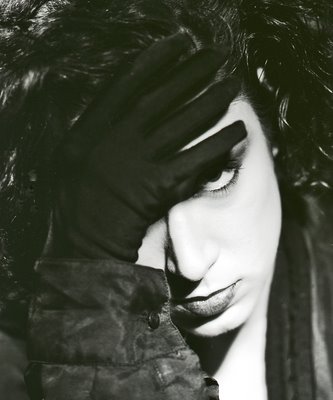
It all started when I started printing my negatives in 1962. I would put a negative in an enlarger and perhaps get 20 interpretations of my shot. I would crop it here and there and make horizontal photographs vertical, and the vertical ones horizontal. But when I purchased my Mamiya RB in 1975, its large viewfinder gave me the impetus to crop in-camera. This is a habit that became obsessive. I never crop. I like the discipline that less freedom gives me in photography. I have to make up my mind before I press the shutter.
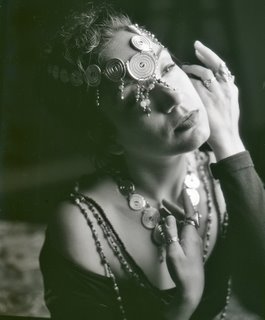
Today when I was perusing some of my files I had a hard look at Kimberley Klaas's. I photographed her three or four times about 15 years ago and judging by the amount of negatives I have of her, I shot a lot. I experimented with all sorts of in-camera crops. And just like some of my students's crops don't work neither do mine.
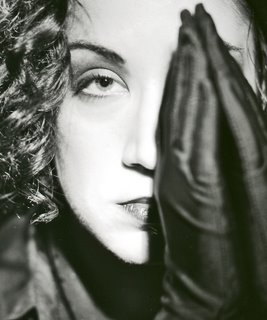
I realize that Klaas had patience as I made her pose in all matter of positions. I also see many photographs that don't look like me idea or are my style. But they work because Klaas was more than a patient subject. She had the gumption to suggest and convince. Thanks to her, and other like her from my past, I can now shoot 5 or 6 pictures instead of a whopping 10!
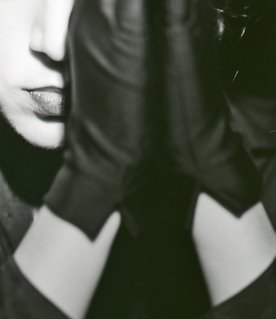
There is a wonderful look to Kimberley Klaas. She looks like a woman that might have hopped on a time machine during the post-war German Weimar Republic and visited me in my studio or might have posed for Man Ray on the way. I don't know where Klaas is now but I am very glad I was able to learn from her when she was around.
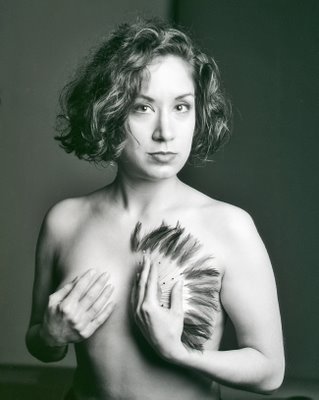 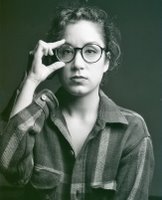 More Kimberley Klaas More Kimberley Klaas
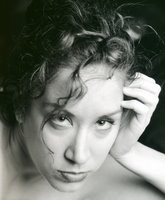
Kimberley Klaas Spademan - 1969-2009
Modelo Al Desnudo - Modeling Nude
Wednesday, May 04, 2011
Guest Blog by Madrid model Dana Moreno López
 |
| Photo by Teco Pablo Salto-Weis |
MODELO AL DESNUDO
Empecé a posar para desnudo casi al mismo tiempo de iniciarme en el posado. Para una modelo no es fácil prestarse a ello, pues la mayoría de las personas lo ven como algo vulgar u obsceno.
I started posing nude almost at the very beginning of my career. For a model posing nude is a tough choice to make, because too many people see it as something obscene or merely vulgar.
Llevo cerca de 12 años posando y bajo mi punto de vista, los/las modelos para fotografía de desnudo suelen coincidir en varios factores: amor al arte, mentalidad abierta y respeto por el cuerpo.
I’ve been posing for the last 12 years or so, and from my experience I think nude models do usually have some characteristics in common: love for art, an open mind and respect for the human body.
En las sesiones de desnudo, como en cualquier otra, asumes tu papel (en función del proyecto y los objetivos), no piensas en el desnudo como objeto sexual sino como una forma de expresión. Una fotografía vestida puede resultar mucho mas erótica que un desnudo simplemente por la mirada o la pose , todo depende de la interpretación de quien posa y de quien percibe la foto desde fuera de una forma subjetiva.
During nude sessions, like in any other type of photo session, you have to play a role that is determined by the type of project you’re into and the goals of that particular session. You simply don’t think about nudity as something sexual, but rather as a tool for expression.
¿El posar desnuda provoca excitación? Si tu papel consiste en mostrar sensualidad ante la cámara te vales de herramientas propias para conseguirlo y asumes tu papel pero ni mucho menos con el fin de excitar al fotógrafo, sino a la cámara ;)
Does posing nude cause sexual arousal? If your role is to show sensuality in front of the lens, you have to use your own talents to do that, and, again, you play a role, but not to excite the photographer, but the camera!
Posar para desnudo resulta más difícil que con ropa. Los complementos siempre son un apoyo para las poses y en el caso de ser sólo desnudo eres tú con tu cuerpo: la expresión del conjunto de tus segmentos corporales unida a la expresividad de tu rostro.
Is posing nude more difficult tan posing fully clothed? Well, being nude doesn’t mean you can’t use props, so that makes things a bit easier to find poses, but in case you have to pose nude in its purest way (by that I mean, just the model with nothing else) then it is all you with your body. The trick is to work with your body and your facial expressions together.
¿Estudio o exteriores?. Me quedo con los exteriores. Para mí no hay mejor reto que buscar es un paisaje o en un escenario (fuera del estudio) dónde puedo tener cabida, cómo puedo formar parte de ese espacio de una forma equilibrada…resulta fascinante.
Studio or on location? For me on location sessions are the best. There is no better challenge than to find a scenery or landscape and trying to figure out a way to fit in it in a balanced way… always fascinating.
Creo que nuestro cuerpo es la base de nuestra vida, un regalo al que hay que venerar y crear culto, algo que nos hace ser iguales al resto de seres humanos y por lo tanto un símbolo de belleza y respeto
I think that our bodies are the core of our life, a gift that should be honored and cherished, something that makes us feel equal to the rest of the human beings, and therefore a symbol of beauty and respect.
Mi Amiga Dana Fotera - My Friend Dana Fotera
 |
| Photo by Jesus Cabrera 2006 |
Mi Amiga, Dana Fotera
Durante una nochebuena silenciosa y mojada de Vancouver en el 2003 me encontraba explorando páginas españolas sobre la fotografía en el Internet. Dirigí mi atención a una muy buena nota en la cual una modelo (Dana Fotera) daba consejos en como tratarse con un fotógrafo antes de una sesión y en especial antes de una sesión al desnudo.
Le escribí y nos hicimos amigos. Compartimos ideas, intercambiamos nuestro trabajo. Lo que más me encantaba de Dana era su entusiasmo, casi una obsesión en posar el desnudo. ¡Y, esas millares de pecas!
Tenemos nuestras diferencias. Muchos de los fotógrafos aún no han aprendido ciertas reglas (quizá reglas inventadas por este viejo) y muestran arrugas del cuello y otras arrugas naturales del cuerpo cuando la pose es un poco forzada. Las arrugas del cuello son un detalle crucial en una modelo tan esbelta como Dana.
Dana parece estar en una constante sesión fotográfica y inmediatamente pone las fotos en su Factbook. No pasa un día en la cual no encuentre alguna nueva foto de mi pecosa favorita.
Una vez se me ocurrió criticar una foto tomada de Dana por un fotógrafo (no todos pueden ser buenos). Y para colmo sugerí que el fotógrafo quizá se dedicara a otra profesión como la plomería.
Obviamente en facebook todo es bueno y la crítica no existe. ¡Aprendí mi lección con el enfade de Dana y varios de sus amigos fotógrafos!
Otro punto de vista en el cual diferimos es mi preferencia por lo que llamo el retrato al desnudo y la preferencia de Dana por la fotografía del cuerpo humano desnudo en un paisaje. Tomando en cuenta la variedad del paisaje no lejos del Madrid de Dana casi entiendo su preferencia.
Pero tengo la ambición de algún día fotografiar a Dana en retrato al desnudo en el cual le pondría especial esmero en mostrar sus pecas, de que es una senda mujer y de alguna manera llegar a la fuente de esa mirada que parece penetrar a las entrañas de mi ser.
My Friend Dana Fotera
A quiet day before Christmas 2003 I was exploring the Spanish (in Spain) photographic sites and I was suddenly aware of an article by a young Spanish model (with thousands of freckles) in which she gave advice on how to discuss with a photographer a future nude session. She gave good practical advice. I was charmed. I contacted her and we became fast internet friends. We exchanged examples of our work but I was especially conscious of her self portraits that had a delightful approach.
We have some differences. Many of the many photographers who photograph her have not learned the ropes yet and they tend to photograph her in a cutesy fashiony way and they seem to not know the rule (is it only my own?) that neck folds should never show. This is especially crucial if a model has little body fat like Dana who is extremely fit.
Dana is constantly having sesiones (sessions) and she is quick to publish them (as if there were a no regret future in the works) on facebook. At first I tried to point out those neck folds and even went as far as telling her that a particular photographer should try a plan B like plumbing. I broke the rule of facebook in which we are all to point out the beauty of everything and how the world is rosy and even rosier to come. She was quite firm in that I should mind my own business and not be so critical. After all who did I think I was? I took the advice but decided on another tack. This was to point out the nice photos, and there are many, where a photographer and she have combined for excellent results.
Dana and I are at opposite ends in an important difference. It is a difference that is still manifest is my fondness for what I call the nude portrait as opposed to her particular preference for the landscape nude, the nude in a landscape. She may be right in this approach as Spain provides her with a multitude of exotic locations just a few hours or at the most a day on a train.
But without too urging she sent me the above essay on how she poses nude. I have yet to find out from anybody the definitive reason why anybody would delight in posing nude. I suspect it is the other side of the coin in my pocket that makes me want to photograph the nude. Where possible I shall keep exploring this medium and I will ask others to see if some day I may have the answer to my question, “Why do you pose in the nude?
I love her huge eyes and that she almost never smiles. I have even more fondness for all her freckles. My ambition (if I ever get to Madrid) is to one day photograph her nude but as a portrait nude where I would emphasize her poise and those direct eyes that go directly to my soul when I look at her pictures.
Dana in a tub, Dana en la tina
Alexandra Norris
She Wrote
Dana and Graham Greene
Needles, Money & Crossing Borders
Tuesday, May 03, 2011
Election night in Canada has been an unsettling one for me for three reasons besides the obvious one that even though I am 68 years old I would not consider myself in the remotest case to be a conservative. The prospect of a Conservative majority is troubling.
Going back to the three reasons, they all happened in my childhood.
I must have been 8 years old when my mother and I went to the ferretería (a hardware store), on Avenida Nahuel Huapi, around the corner from our house on Melián in Buenos Aires. I don’t remember what it was that I wanted (it was hanging from the ceiling next to hundreds of other stuff). I told my mother I wanted it. My mother went into her handbag and pulled out a brand new bill (it was blood red) and she held I with her two hands. She made a noise as she flicked and stretched it and told me, “If you want that I would have to use this and it is a big bill. You will have to learn the value of money if you are going to get it and it is not going to be today.”
It was at about that time that once a year we got our shots at the infirmary (the age of fluorescent red mercurochrome that stung!) at Colegio Ward where I was taught in Spanish in the morning and English in the afternoon. I did my best to avoid going on that day but my mother gave me no choice. The day in question was when we got our diphtheria shot. This shot was applied on the middle back where the spine was. To me it felt like someone was plunging a dagger. The anticipation before the nurse hit my back with the needle was the worst part. I was scared to death and have been scared to death of needles since.
Needles go hand and hand with blood and I cannot look at blood. When I go for blood tests I have to look elsewhere as the sight of the brilliant red makes me swoon like a Victorian woman with consumption.
 |
My mother's Argentine passport
Filomena de Irureta Goyena |
Because my mother had married a divorced man and Argentina did not consider her Uruguayan wedding certificate a valid one, for all intents and purposes I was a bastard son. This was especially so when we would go to the Policía Argentina for a document of any kind. She was Filomena de Irureta Goyena (even though my father was George W. Hayward) and I was Jorge Alejandro Hayward (the Waterhouse came later). I had been born on August 31, 1942 but for reasons I will never understand my birth certificate had April 18, 1943 as the date when I entered the world in Buenos Aires at the Hospital Anchorena. All those anomalies meant that my mother always grilled me on what I had to answer if an official asked me for my name and date of birth.
 |
Jorge Alejandro Waterhouse Hayward
My universal identity document |
Crossing borders by the time I was 11 in Mexico was something that I did not look forward to. We were always at the mercy of a petty bureaucrat who would decide that it was impossible that I would be my mother’s son if I had a different name.
 | Jorge Alejandro Hayward Name change on my Argentine passport
J A W. Hayward & finally inside |
On 27 August 1960, I left for school in Austin, Texas via Piedras Negras, Coahuila . Some idiot official forgot to stamp my exit on my Mexican immigrant document. When I returned for a Christmas vacation the man at the airport told me,”Jovencito, my name then was Jorge Alejandro Waterhouse de Irureta Goyena (no Hayward), it is impossible that you are entering this county as you never left it.” That statement cost us hundreds of dollars and weeks of lining up at Gobernación where immigrants went for documents. We had to deal with coyotes, illegal, go-betweens who for a fee would “ease” the trámites or paper work.
 |
| A coyote had to intevene for the exit stamp that never was |
The result of all the above is that I hate crossing borders, I hate injections and blood and I have no interest in understanding the value of money and how to deal with it.
Thankfully my wife Rosemary has always handled the money. I tell my friends that Rosemary wears the financial pants in our family. Thankfully Rosemary does our taxes and thankfully Rosemary knows how to fill out application forms and any other kinds of documents.
But the buck stopped today. I had to see my family doctor to have him teach me how to inject myself every two weeks with my arthritis medicine which is much more effective if injected and not taken as a pill. I have been taking the pills for almost four months with little relief.
It seems that my doctor taught me well and I was able to inject myself well and almost without pain. But there was a warning that stiffened me up. Before you press the medicine in, pull the plunger out a bit to make sure you are not hitting a vein. If you see blood you have to start again.
Rosemary has been on the rampage all day doing the taxes and I feel like an appendix, useless. At least I am able to explain how to go to the next step in U-File which is the program she is using. But I know I have to keep quiet and not try her patience. She plainly told me, all nervous and worked up; I cannot do your taxes anymore.
I thought that my taxes should be fairly easy to do next year as with employment at zero, income is at zero and thus it must all be easy. Or will it? I will find out next year. And by then I will be an expert with my hypodermic needle.
But as my doctor prescribed something called Flomax to ease the strain on my plumbing I have been told that Flomax will be more expensive next year if Harper has a say.
Voting With My Head & Not With My Heart
Monday, May 02, 2011
 |
| Jack Layton, Photo Alex W-H |
If someone asked me what I do best as a photographer I would argue that I am the best political portrait photographer in the business. Unfortunately, from the point of view of taking pictures of people in power, my political portraits have been of the Federal and Provincial NDP. This means that the only time that I photographed candidates who were elected to positions of such power happened only when my campaign poster of Mike Harcourt was of the man who indeed did become Premier. Years later, in 2002, I photographed Ujjal Dosanjh when he was BC Premier, but he lost. Until now I have photographed all the men and women of BC’s NDP who have been the leaders of the opposition.
In Sept 2003 I was hired to take photographs of Jack Layton for the upcoming election of 2004. The man came to my Robson Street studio and I instantly liked him and I enjoyed taking his photographs. Unlike Carol James, who always sent me a thank you card and a Christmas card I received no thanks from the busy man. It seemed that James was gracious and Layton efficient.
When in 2004, there was a danger that Stephen Harper, of the Federal Conservative Party, could win the election I was in a quandary. In my area of the city the Liberal candidate was Ujjal Dosanjh. The folks who had hired me to photograph the NDP candidates were not happy with the fact that Dosanjh had jumped the NDP ship for the Liberals.
At the time I realized that my vote for the NDP candidate (one I don’t even remember now) would be a wasted vote as the NDP had no chance of forming a government or coming anywhere near a distant third to the Liberals and Conservatives.
On election night I became so scared at the possibility of a Harper victory that I participated in the Tyee election night forum and wrote:
I have photographed both Jack Layton and Ujjal Dosanjh. I respect and admire both men. If I voted with my heart I would vote for my NDP candidate in my riding but I think I must vote with my head and vote Liberal.
That very evening on the CBC’s national coverage of the elections my statement was pasted on the TV screens across the nation.
Shortly after, a few weeks later I was told through an inside source that Layton had personally black-balled me and that I was not to get any work again to photograph any NDP candidate.
My friends all told me that I had been a disingenuous idiot. Fortunately I still photographed many Provincial NDP MLAs, MPs and Carol James herself because they requested I photograph them.
Tonight, Sunday night, as I write this if I were to post something on the Tyee tomorrow I would write:
I have photographed both men, Jack Layton and Ujjal Dosanjh. If I were to vote with my heart I would vote Liberal for Dosanjh. But I must vote with my head (I want my vote to count so Harper will not get a majority) for my riding candidate NDPs Meena Wong.
Antes Del Fin - Before The End
Sunday, May 01, 2011
cómo se pasa la vida,
cómo se viene la muerte
tan callando
how life passes,
how death comes
so quietly
Jorge Manrique, 1440-1479
Back in 1966 when I was a conscript in the Argentine Navy I would sometimes be dispatched to Electrónica Naval. This was a large building near one of the oldest and most beautiful parks in Buenos Aires. The park was called Parque Lezama. I was dispatched to Electrónica Naval with purchase orders and documents from the US Senior Naval Advisory Group (I was seconded to them, by the Argentine Navy, because of my English). The Argentine Naval department had the task of repairing and maintaining the elecronics (and avionics) of slightly old equipment that had been purchased from the US like the Douglas Skyhawk fighter jets. What my boss Captain USN Onfrio Salvia did not know (or knew but kept it to himself) is that the radar parts that were obtained for free from the US were used to build and assemble TV sets (carpenter sailors built beautiful cabinets) that where then sold to the public with greata profit to the upper hierarchy of the Argentine Navy.
I often lingered at Parque Lezama (I would always complain of the terrible Buenos Aires bus system to explain my delay) and I would sit, meditate on my existence and try to understand that I really had little of the free will we were supposed to be born with as the navy controlled my life and most of my actions.
I did not know then that if I might have lingered longer I might have spotted two men walking arm in arm perhaps meditating and discussing the very subject that kept me occupied.
The two men in question were Jorge Luís Borges and Ernesto Sabato. They are my two favourite Argentine writers and Sabato’s Sobre Héroes y Tumbas is in my opinion the definitive Argentine novel that defines who we Argentines are (or in my case as I am now a Canadian, what I was).
Central to Sobre Héroes y Tumbas is a church in Belgrano on Juramento Street in Buenos Aires that is affectionately called la Redonda (the Round One). It is a church I often went to Mass to. In this church, Padre Filippo (who was Eva Perón’s confessor) sermonized us that we should become Peronists if we wanted to be saved.
Some six years ago I returned to la Redonda with my granddaughter Rebecca and she and my godmother Inesita O’Reilly de Kuker sat for Mass and then for a breakfast of café con leche and medias lunas.
I don’t think I have ever seen a photograph of Ernesto Sabato smiling. The man was a genius physicist who lost his interest in pursuing his career in Paris because of what was being done with atomic weapons. He decided to write. Most of what he wrote was not full of alegría but definitely on the morose and depressing.
Sábato wrote a sort of memoirs called Antes del fin or Before the End. I bought the book when it was published in 1999. The book is a continuous jolt of the mind. It is a book I often read when I am happy as I sometimes feel guilty about being happy (perhaps this is very Argentine or Sabato-like). Just reading the initial essay you see here which I translated into English the best I could is enough to wipe the smile from my face.
Yesterday from my NY Times I found out that Ernesto Sabato died at age 99. I find it interesting and appropriate to the man that he may have written one of the most beautiful of postscripts to a life quite a few years before he actually died.
He sort of reminds me of my father who died on the street with enough money in his pocket with which I the Argentine Navy sailor without any money, was able to pay for a humble but decent burial.
I just woke up and it will soon be five in the morning; I try not to make a noise, I go to the kitchen to make myself a cup of tea while I try to remember the fragments of my drowsy dreams, those drowsy dreams which now that I am 86 years old present themselves helter skelter mixed with remembrances of my childhood. I never had a good memory, I always suffered from that disadvantage; but perhaps it might be a form of only remembering what must be, what may have been the largest event that happened in my life, what has a deep significance, what has been decisive – for good and for bad – in this complex, contradictory and unexplainable voyage towards death which is everybody’s life. That is why my culture of understanding is so irregular and full of glaring holes, as if it were made up of the remains of beautiful temples of which only pieces were left scattered wih garbage and wild foliage. The books that I read, the theories I explored, happened because of my run ins with reality.
When I am stopped on the street, on a park or train and I am asked which books one must read, I always tell them: "Read what you have a passion, it will be the only thing that will help you tolerate existence."
That is why I eliminated the title Memoirs and also Memoirs of one without memories for this book as it seemed only a play on words, inadequate for this testament, which I have written in the saddest period of my life. In this period when I feel crippled in not being able to remember immortal poems about time and death that would console me in these final years.
In the country town where I was born, before we would retire to sleep, we had the custom of asking that we would be wakened up in the morning with: " Remember me at six." I always marveled at that relation that was made between memory and the continuation of one’s existence.
Memory was highly appreciated by great cultures, as a way of coping with time. It was not simply the remembering of ordinary every day happenings, nor that memory that serves to store information in today’s computers: I speak of the necessity of nurturing and transmitting to others the basic truths.
In archaic communities, while the father was out to find food, and women wove baskets or tended the crops, the little ones, sitting on the laps of their grandfathers, were educated in their wisdom; not in the sense that our scientific world defines that word, but in that type of wisdom that helps us to live and die; the advice of those counselors, who were mostly illiterate, but as one day the poet Denghor told me in Dakar: the death of one of those old men is what for you, now, would be the burning of a library of poets and thinkers. In those tribes, life had a sacred and profound meaning, and their rites were not only beautiful but also mysterious in their purpose, they consecrated the fundamental underpinnings of reality: birth, love, pain and death.
As I lie in the shadows, in the middle of my sorrows and tiredness, like one of those ancient old men, within the reach of the heat of the embers of a fire and remembered their ancient rites and legends, I resolve to tell some of the events of my life, mixed and diffuse which have been part of profound and contradictory tensions, of a live full of chaotic and messy wrong turns, in my desperate search for truth.
Antes del fin by Ernesto Sábato and translated by me.
 |
| Photo uncredited in my copy of book |
Me acabo de levantar, pronto serán las cinco de la madrugada; trato de no hacer ruido, voy a la cocina y me hago una taza de té, mientras intento recordar fragmentos de mis semisueños, esos semisueños que, a estos ochenta y seis años, se me presentan intemporales, mezclados con recuerdos de la infancia. Nunca tuve buena memoria, siempre padecía de esa desventaja; pero tal vez sea una forma de recordar únicamente lo que debe ser, quizá lo más grande que nos ha sucedido en la vida, lo que tiene significado profundo, lo que ha sido decisivo – para bien y para mal – en este complejo, contradictorio e inexplicable viaje hacia la muerte que es la vida de cualquiera. Por eso mi cultura es tan irregular, colmada de enormes agujeros, como constituida por restos de bellísimos templos de los que quedan pedazos entre la basura y las plantas salvajes. Los libros que leí, las teorías que frecuenté, se debieron a mis propios tropiezos con la realidad.
Cuando me detienen por la calle, en una plaza o en el tren, para preguntarme qué libros hay que leer, les digo siempre < Lean lo que les apasione, será lo único que los ayudara a soportarla existencia.>
Por eso descarté el título de Memorias y también de Memorias de un desmemoriado, porque me pareció casi un juego de palabras, inadecuado para esta especie de testamento, escrito en el período más triste de mi vida. En este tiempo en que me siento un desvalido, al no recordar poemas inmortales sobre el tiempo y la muerte que me consolarían en estos años finales.
En el pueblo del campo donde nací, antes de irnos a dormir, existía la costumbre de pedir que nos despertaran diciendo:>>Recuérdenme a las seis.>> Siempre me asombró aquella relación que se hacía entre la memoria y la continuación de la existencia.
La memoria fue muy valorada por las grandes culturas, como resistencia ante el devenir del tiempo. No el recuerdo de simples acontecimientos, tampoco esa memoria que sirve para almacenar información en las ahora computadoras: hablo de la necesidad de cuidar y transmitir las primigenias verdades.
En las comunidades arcaicas, mientras el padre iba en busca de alimento y las mujeres se dedicaban a la alfarería o el cuidado de los cultivos, los chiquitos, sentados sobre las rodillas de sus abuelos, eran educados en su sabiduría; no en el sentido que le otorga a esta palabra la civilización cientificista, sino aquella que nos ayuda a vivir y morir; la sabiduría de esos consejeros, que en general eran analfabeos, pero como un día me dijo el gran poeta Senghor, en Dakar: >>La muerte de uno de esos ancianos es lo que para ustedes sería el incendio de una biblioteca de pensadores y poetas.>> En aquellas tribus, la vida poseía un valor sagrado y profundo; y sus ritos, no solo hermosos sino misteriosamente significativos, consagraban los hechos fundamentales de la existencia: el nacimiento, el amor, el dolor y la muerte.
En torno a penumbras que avizoro, en el medio del abatimiento y la desdicha, como unos de esos ancianos de tribu que, acomodados junto al calor de la brasa, rememoraban sus antiguos mitos y leyendas, me dispongo a contar algunos acontecimientos, entremezclados, difusos, que han sido parte de tensiones profundas y contradictorias, de una vida llena de equivocaciones, desprolijas, caótica, en una desperada búsqueda de la verdad.
Rebecca & Inesita a La Redonda
Of Bats and Cockroaches
Captain USN Onofrio F. Salvia, Kapitän Langsdorff Shoots Himself & I Get A Haircut
On Memory
|

































